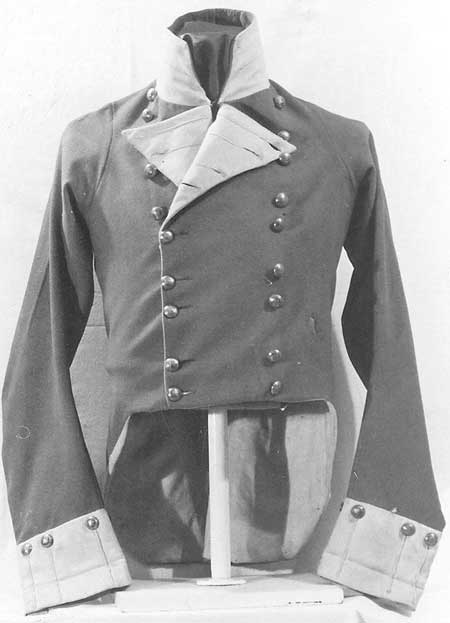Chapter Four
Conflict in the Coastal Waters
Though a state of neutrality existed along the land frontier between Maine and New Brunswick, that was not the case along the Atlantic seaboard. Coastal communities and seaborne communications came under attack from the moment war was declared. Britain was the world’s dominant naval power and, after twenty years of continuous victories, the Royal Navy, which boasted of about a thousand ships, was prone to a superiority complex. Its admirals believed they alone protected not only Britain but the whole world from Napoleon’s ambitions. With Napoleon the prime threat, the navy was reluctant to divert ships to American waters, with the result that the North American Squadron, stationed in Halifax under the command of Vice-Admiral Herbert Sawyer, consisted of only twenty-seven vessels. It was not until October 1812 that Sawyer attempted to blockade a portion of the US Atlantic coast, and then only Georgia and South Carolina. This limited blockade was in line with Admiralty instructions to punish the American South, which supported the war, and not to harass the New England states, which opposed it. Despite its limited numbers, however, the North American Squadron was never seriously challenged by the US Navy.
As a result of the policies of the Jefferson administration and then the inaction of the Monroe administration, the US Navy was pitifully small — a mere squadron of eight frigates and twelve sloops, not all of which were ready for sea — and unprepared for war. Its strength lay in its experienced crews of professional sailors and well-designed and well-built frigates. There was, however, heated debate within the navy and the government on how best to employ the ships. In the short period between receiving word that war had been declared and before receiving unwanted direction, Commodore John Rodgers took matters into his own hands and set sail from New York with three frigates — U.S.S. President (forty-four guns), U.S.S. United States (forty-four guns), and U.S.S. Congress (thirty-six guns) — the sloop U.S.S Hornet (eighteen guns), and the brig U.S.S. Argus (sixteen guns). Hoping to take advantage of surprise, his goal was to engage isolated British warships before they were aware war had been declared and to intercept a British convoy of a hundred fully laden merchantmen that had recently sailed from Jamaica. Rodgers’s squadron soon encountered H.M.S. Belvidera (thirty-six guns). Although surprised and outgunned, damaged, and with casualties, the British frigate escaped to spread the word that hostilities had commenced. Lieutenant Le Couteur of the 104th Regiment saw Belvidera arrive in Halifax on June 26, 1812, with “no boats, no anchors, and shot holes through her sails.” Admiral Sawyer immediately formed a squadron and issued orders to “find Rodgers and destroy him.” The Royal Gazette and New Brunswick Advertiser haughtily wrote, “if Commodore Rodgers chooses, he will soon have a more dignified opportunity of displaying the prowess of the American Navy.” As fate would have it, the two squadrons failed to meet, the Jamaican convoy arrived safely in England, and, after a seventy-day cruise, the American squadron returned to port, never again to challenge British naval supremacy. In the first six months of the war, however, the Royal Navy’s confidence was badly shaken by its defeat in five single-ship engagements with American frigates. Although these actions had no strategic value, they were extremely embarrassing, and gave a needed boost to American pride that would be long remembered. Only in the sixth engagement, between the frigates H.M.S. Shannon and U.S.S. Chesapeake, did the British finally secure a victory.
Due to restrictions placed on sea-bound trade by the US government and the British blockade, American ports were full of unemployed sailors and idle ships. Many shipowners, fearing the uncertainty of war, kept their vessels tied up for the duration, but there were those who saw opportunities. To the adventuresome, privateering offered the possibility of quick and easy wealth. American ports were soon busy outfitting privateers ranging in size from several hundred tons with a crew of one hundred and fifty to open whaleboats manned by a dozen men armed with muskets. During the course of the war, more than five hundred American privateers took to the seas, of which 192 sailed from ports in Massachusetts. A congressman called the privateers “our cheapest and best navy.” A Letter of Marque and Reprisal granted by the government to a private shipowner gave the right to attack enemy shipping and to keep most of the proceeds from the sale of the vessels and cargoes he captured. Within the first month of the war, The Royal Gazette and New Brunswick Advertiser reported, “American Privateers are swarming around our coast, and in the Bay of Fundy, hardly a day passes but we hear of captures made by them.”
After applying for a Letter of Marque, Captain William Webb equipped his thirty-ton schooner Fame with two small cannon and a crew of two dozen unemployed sailors. On July 1, 1812, he sailed from Salem, Massachusetts, and headed for the busy shipping lanes around Grand Manan Island in the Bay of Fundy, where, without firing a shot, he captured the three-hundred-ton Concord out of Plymouth, England, and the two-hundred-ton Elbe from Scotland. These were the first prizes captured by American privateers in the war. When the two captured ships and their cargoes were sold at auction, the money realized was ten times the value of the Fame. This success encouraged others to become privateers, and the waters off Grand Manan became a favourite hunting ground.
On June 30, 1812, a British military transport sailed from Halifax for Saint John in the belief that American privateers had not yet appeared in the Bay of Fundy. This notion was quickly disproved, however, when the transport was captured four days later by the Salem privateer Madison. The cargo of the captured transport included 880 uniforms, camp equipment, and band instruments for the 104th Regiment, a loss the regiment sorely felt for a long time. When the privateer Jefferson, armed with a single swivel gun and ordered to leave Eastport “without molesting anyone,” crossed over to Snug Harbour on Campobello Island, where it captured a schooner and unsuccessfully attempted to take a second. The Jefferson then went on to capture the schooner Nymph in Passamaquoddy Bay and the schooner Argyle in Beaver Harbour, but failed to take a four-gun ship sailing out of St. Andrews. When it was learned that privateers intended to attack a large ship loading lumber at Digdegush, the Charlotte County Militia mustered a detachment for its defence and the attack never materialized. In another incident, the British barque William, sailing from St. Andrews, was captured by an unknown American privateer, but was recaptured by H.M.S. Indian (eighteen guns) and safely sent to Halifax. The Royal Gazette and New Brunswick Advertiser reported the capture of the Nova Scotian schooner Friendship by the privateer Wasp off St. Andrews. The Friendship’s captain was taken to Machias, Maine, and “put in irons, plundered of all his cloths, money, watch, etc., and otherwise cruelly treated.” The 300-ton copper-bottomed Ned from Glasgow, loaded with lumber, sailed from Saint John and was attacked by the New York privateer Teazer. With the assistance of the fourteen-gun sloop Comet, this attack was beaten off and the Ned continued on alone. Off Grand Manan, the Ned was attacked again, this time by the fifty-seven-ton privateer Revenge armed with one long gun. After a five-hour chase and a three-and-half-hour exchange of gunfire, the Ned surrendered. From the very beginning of the conflict, sailing the Bay of Fundy was hazardous.
This extensive privateer activity forced British merchantmen to seek safety in convoys. In mid-July 1812, for example, a convoy escorted by the sloop H.M.S. Indian sailed for Europe from Saint John after stopping at Head Harbour on Campobello Island to collect Europe-bound ships from St. Andrews. In addition to convoy duty, the Royal Navy attempted to sweep American privateers from the Bay of Fundy. In August, H.M.S. Maidstone (thirty-six guns) and H.M.S. Spartan (thirty-eight guns) drove the Portland privateers Mars and Morningstar ashore after a stiff fight near Quoddy, opposite Campobello, and burned them. In the first few months of the war, the Royal Navy captured thirteen privateers, the U.S.S. Nautilus (fourteen guns), and the U.S. Revenue Cutter Commodore Barry. Unfortunately, this did not deter American privateers; in the same period, they captured 219 vessels, mainly from the Bay of Fundy and off Newfoundland.
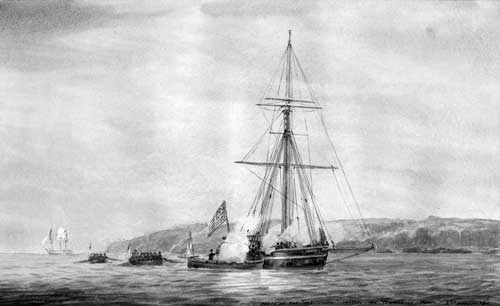
Capture of the U.S. Revenue Cutter Commodore Barry in August 1812; New Brunswick later bought this ship and converted it to Brunswicker. Mariners’ Museum
A fine line existed between privateering and piracy. While a Letter of Marque and Reprisal entitled the holder to attack and seize enemy ships, activities that were controlled by strict regulations, it did not include the right to conduct raids on land. Too often, however, American privateers were not troubled by the finer points of the law, and the Fundy Isles and the Charlotte County coast, in particular, were subject to frequent raids. In one incident that received considerable press, two raiders audaciously entered the bedroom of David Owen, the squire of Campobello Island, demanding money and threatening to kill him and burn his house down. The privateer Weasel, an open whaleboat out of Castine, Maine, commanded by Edward Snow, “a preacher of the gospel,” mounting only one gun and manned by a dozen men, raided Beaver Harbour in June 1813. As reported in the Royal Gazette and New Brunswick Advertiser, “these marauders plundered . . . almost every article they could lay their hands on, taking even the wearing apparel of the women and children.” They seized a boat belonging to a Captain Cross, which, along with their boat, they loaded with loot. On departing, the privateers boasted “they were sorry they had not more boats to load.” Members of the Charlotte County Militia on Deer and Campobello islands reacted quickly, manning three boats to go in search of the raiders. Captain Cross’s schooner was recaptured and the Weasel was driven ashore on Grand Manan. One privateer was captured but five others escaped into the woods, eventually making their way across the island to Seal Cove, where they stole a large boat and sailed back to Maine. Some raids had a humorous element. Privateers appeared at Joseph Blanchard’s farm at Seal Cove on Grand Manan and demanded potatoes. He replied that he was now a British subject and “would not afford succor or feed the enemies of King George.” Pointing to his potato field, he said, “there are the potatoes, and if you are rascals enough to steal them — you must dig them.” The privateers left empty handed. The Royal Navy reacted forcefully to these violations of the privateering code. Up to this point, American fishing boats had not been molested, but, incensed by the Beaver Harbour raid, Captain Alexander Gordon of H.M.S. Rattler, the senior naval officer on station, declared that they were now liable to capture or destruction.
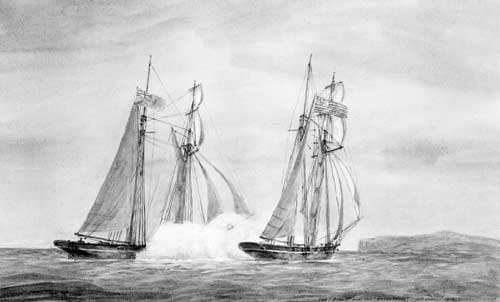
H.M.S. Bream capturing the American schooner Pythagoras off Shelburne, NS, after a twenty-minute action in August 1812. Mariners’ Museum
In an attempt to provide better protection, the seventy-two-ton schooner H.M.S. Bream (four guns) under the command of Lieutenant Charles Hare, was stationed in Saint John in August 1812, where it remained until the summer of 1814. The vessel actively patrolled the Bay of Fundy, bringing in her first two prizes on November 19. Clearly, however, Bream alone could not provide New Brunswickers with the level of protection they wished. On the advice of his Council, General Smyth purchased at auction the recently captured US Revenue Cutter Commodore Barry and renamed her Brunswicker. This approximately eighty-ton vessel fitted for ten guns was placed in the charge of Lieutenant-Colonel George Leonard, the quartermaster-general, with detailed instructions issued by Smyth. Her prime purpose was to protect coastal trade, and she was to be “considered a vessel for the general service of the Province, and not just for St. John alone.” Brunswicker was not to sail west beyond Passamaquoddy Bay, “except actually in chase.” She was to have a permanent establishment of a captain, a mate, and six able-bodied seamen, which was to be augmented as required when she sailed. Brunswicker arrived in Saint John on November 1, 1812, and began operations almost immediately, mainly in cooperation with H.M.S. Bream. The Royal Gazette and New Brunswick Advertiser reported that these two ships sailed in search of two privateers operating off Point Lepreau, and that “upwards of 20 seamen belonging to the different ships in the harbour, volunteered their services on board the Brunswicker, as did also several citizens.” A Boston newspaper reported that the two ships had chased three American privateers — the Fame, Revenge, and Industry — from the Bay of Fundy.
In another initiative, General Smyth issued Letters of Marque and Reprisal to New Brunswick shipowners. Unfortunately, he began to do so in the four-month period between the respective American and British declarations of war, creating a legal dilemma. Since the British Empire was not technically at war when Smyth’s first letters were issued, New Brunswick privateers could not accrue any profit they realized from American prizes. A number of other irregularities involving privateers holding Letters of Marque signed by Smyth followed, with the result that, in mid-1813, he was forbidden to issue any others. That, however, did not deter New Brunswickers, who simply applied to General Sherbrooke in Halifax. During the course of the war, ten known Letters of Marque were issued to New Brunswick shipowners, some of whom became quite successful privateers. Among the first were the owners of the forty-eight-ton sloop General Smyth with four guns and the fourteen-gun sloop Comet, both out of Saint John. The most famous was the forty-seven-ton Dart, armed with four carronades and two swivel guns and manned by a crew of forty-five. She successfully brought into port eleven American prizes.
To defray the cost of purchasing and outfitting Brunswicker, Smyth applied to the British government for financial support. This request piqued Lord Bathurst, the secretary for war and the colonies, who responded promptly by asking why a project had been undertaken of “an Expense of so unusual a nature without previous sanction of His Majesty’s Government.” He noted petulantly that Smyth had reported his satisfaction with the protection provided by the Royal Navy and that, if he required more support, why had he not requested it. Not only was the request for reimbursement refused, Smyth was also ordered not to incur any further expense. On January 21, 1813, Smyth informed the House of Assembly of the British government’s decision and forwarded an estimate of future expenses. He then asked if it was “expedient to continue [Brunswicker] on service of the Province.” The House recomended discharging “the said sloop for public service, and as soon as he shall deem it expedient dispose of her,” noting that “the expense of employing her will be greater than funds of the Province can bear” and besides, “there is now a naval force at the command of the Admiral upon the station, of sufficient magnitude to justify a well grounded expectation that the Province will be thereby sufficiently protected.” Brunswicker ceased operation by the end of March 1813 and arrangements were made to dispose of her. So ended New Brunswick’s own provincial navy, whose memory, however, is perpetuated by H.M.C.S. Brunswicker, the naval reserve unit located in Saint John.
As the House of Assembly had observed, by spring 1813 the situation along the Atlantic coast had changed. Sawyer had been replaced by Vice-Admiral Sir John Borlase Warren and the squadron strengthened to ten ships-of-the-line, thirty-eight frigates, and fifty-two smaller vessels. The Admiralty also promised two battalions of Royal Marines. In an attempt to prevent or delay the move of American troops to the Great Lakes region, Admiral Warren was instructed to raid the US Atlantic coast while continuing the blockade. With the naval resources available, it was accepted that the extensive enemy coastline could not be blockaded completely, necessitating the targeting of key ports and areas. Accordingly, the Royal Navy concentrated on Chesapeake Bay, Delaware Bay, Boston, New York City, Charleston, Port Royal, Savannah, and the mouth of the Mississippi. By April 1813, ships under Rear Admiral Sir George Cockburn were successfully conducting raids into Chesapeake Bay, demonstrating with ease that the Royal Navy could operate with impunity anywhere it pleased. Although the blockade was porous, it devastated American seaborne trade, and the US Navy was helpless to prevent this violation of American sovereignty.
As the number of Royal Navy vessels operating along the Atlantic coast increased, Saint John became a major port of call, resulting in profound economic and social growth of the fledgling city. It provided a refuge in poor weather, a supply point, and a place to form up convoys. Warships, privateers, merchantmen, and captured prizes filled the harbour, stretching Saint John’s facilities to the limit. Since there was neither a naval hospital nor the possibility of establishing one, Captain Gordon, the senior naval officer on station, requested that use be made of the vacant capacity in the Ordnance Hospital, and Major Henry Phillott, the officer in command, readily agreed. This practical and commonsense approach did not, however, take into account bureaucracy: when Dr. Adino Thomas Paddock requested reimbursement of £19 “for the maintenance and medical treatment” of the sick and wounded from H.M.S. Bream, government bureaucrats refused on the grounds that this transaction between services was “not authorized by any regulation.” The custody of prisoners of war (P.O.W.s) also had to be addressed. Since prisoners hampered the warships on which they were held, they were disembarked as soon as possible. In Saint John, arrangements were made to hold them in the city and county jail until they could be transported to the British-operated P.O.W. prison on Melville Island in Halifax Harbour. A detailed invoice giving the names of American prisoners held from July 1812 to June 1813 indicates that 189 P.O.W.s were confined in Saint John at a cost of £93 10s 9d. The difficulty of handling prisoners was evident in the request by Lieutenant Z. Wheeler of the Saint John Sea Fencibles for a court martial to assess the charge against him of “being accessary [sic] to the escape of an American prisoner by the name of Rich.” The court found that Wheeler “appears to stand perfectly exonerated from the charge.”
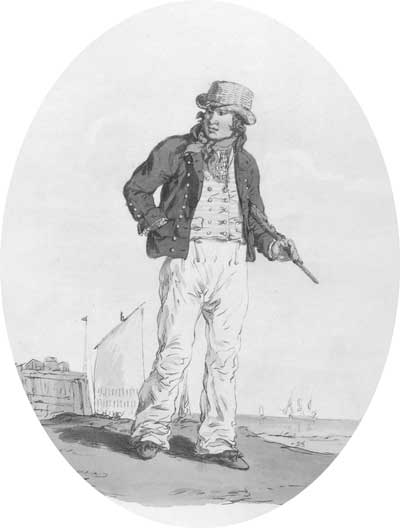
Seaman of the Royal Navy ashore. Arts and Architecture Collection, New York Public Library 1146965
The increased activity in Saint John harbour also provided ample employment opportunities. In July 1812, the Royal Gazette and New Brunswick Advertiser reported that “20 to 30 fine young men belonging to this City, volunteered for a three months cruise on board HMS Spartan.” Later the same year, the privateer Comet sought “twenty-one able-bodied SEAMEN and LANDSMEN to complete the Crew of said Ship — generous wages will be given on application.” The harbour also experienced its share of accidents. In November 1813, sparks from a lamp lit by the cook on board the Little Fox ignited a small keg of powder left carelessly nearby. The resulting explosion severely damaged the ship and “scarcely a man on board escaped unhurt, several very badly.”
The treacherous weather and sailing conditions in the Bay of Fundy could play havoc with naval operations. H.M.S. Plumper, a brig armed with twelve 18- and 12-pounder guns and with a crew of fifty, had been on convoy duty and cruising in the area since July 1812, during which time it had taken several prizes. On the morning of December 5, 1812, en route to Saint John from Halifax with about seventy-five crew and passengers aboard, Plumper hit a ledge of rock off Dipper Harbour, since named Plumper Head, and sank in a raging snowstorm. Although her captain, Lieutenant Josias Bray, was among the survivors, forty-two perished. Of particular concern was that Plumper was carrying £36,000 sterling in gold and silver specie to pay the British garrison. Within forty-eight hours, both Bream and Brunswicker were despatched to secure the wreck and begin salvage operations. A week later, Captain Maclauchlan of the Royal Engineers reported that the greater part of the money had been secured and that Lieutenant Playfair of the 104th had volunteered to use a diving bell in an attempt to recover more. It was not the money that Maclauchlan lamented but the loss of the iron works carried onboard that he required for the gun carriages he was constructing. The wreck of H.M.S. Plumper is now a protected provincial historic site.
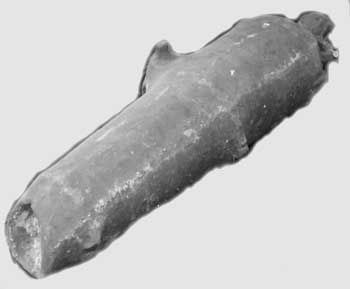
Carronade recovered from H.M.S. Plumper, sunk off Dipper Harbour, NB, in December 1812. New Brunswick Museum
Foul weather was responsible for another crisis. With the arrival of American reinforcements under General Ulmer at Eastport and the planned departure of the 104th Regiment, concern for the security of Saint John increased. To meet Smyth’s urgent request, Sherbrooke shipped ten 24-pounders to establish batteries on Partridge Island, along with ammunition, muskets, and other military stores. On January 5, 1813, a convoy consisting of the Diligence and Lady Johnston sailed from Halifax under the protection of H.M.S. Rattler. Off Cape Sable, they encountered a severe snowstorm and the convoy became separated. The Lady Johnston was captured by privateers and the Diligence was blown ashore on Beale’s Island, twenty miles from Machias, Maine. Captain Charles Simonds left the mate and crew to defend the ship while he sought assistance. He returned a week later to find the crew gone and the Americans plundering his ship. With great courage, Simonds drove the Americans off and regained possession. When it proved impossible to refloat the Diligence and with the Americans gathering to attack, he set fire to the vessel and escaped. The mate and crew also arrived safely in Saint John after capturing an American schooner. The Americans salvaged the wreck and made a rich haul. From the convoy, only H.M.S. Rattler, with four hundred muskets onboard, arrived safely in Saint John. The loss of this war material was a substantial blow to the defence of New Brunswick at a vulnerable time.
